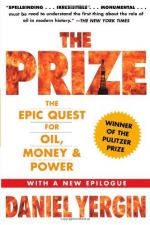
|
| Name: _________________________ | Period: ___________________ |
This test consists of 15 multiple choice questions and 5 short answer questions.
Multiple Choice Questions
1. Japan invaded which country in 1931?
(a) China
(b) Russia
(c) Korea
(d) India
2. By 1950, what was the primary fuel source in America?
(a) Coal
(b) Synthetic fuel
(c) Oil
(d) Electricity
3. In 1944, the Allies targeted what with bombings in Germany?
(a) Concentration camps
(b) Synthetic fuel plants
(c) Tank factories
(d) German submarines
4. Oil prices dropped after what event?
(a) The Vietnam War
(b) The Civil War
(c) World War I
(d) 9/11
5. Who volunteered to lead a cross-country motor caravan to demonstrate the value of motor transportation and to dramatize the need for better highways?
(a) Theodore Roosevelt
(b) Dwight D. Eisenhower
(c) Albert B. Fall
(d) Calvin Coolidge
6. What denied foreign interests access to drilling rights on public lands if their governments denied similar access to Americans?
(a) Oil Dependency Act of 1923
(b) Oil Drilling Act of 1922
(c) Foreign Oil Act of 1919
(d) Mineral Leasing Act of 1920
7. What "taboo" did Venezuela break in the 1940s?
(a) Taking less than market value for its oil production
(b) Breaking an oil agreement for a better deal
(c) Allowing a foreign country to partner with domestic oil companies
(d) Selling the royalty oil directly on the world market
8. Who did FDR meet with at the Suez Canal Zone after Yalta?
(a) Joseph Stalin
(b) David McNaughton
(c) Ibn Saud
(d) Erwin Rommel
9. In the early 1930s, the United States provided how much of Japan's oil imports?
(a) 90%
(b) 57%
(c) 40%
(d) 16%
10. Which act gave FDR power to control exports, including oil?
(a) Imbargo Act of 1939
(b) Manchurian Act of 1937
(c) National Defense Act
(d) Export Safety Act
11. What method of delivery for oil did the oil companies settle on to avoid teamster conflicts?
(a) Trains
(b) Pipelines
(c) Tanker trucks
(d) Boats
12. Who struck a deal with Saudi Arabia for $9.5 million up front; $1 million a year, whether or not oil was pumped; and a royalty of $0.55 per barrel?
(a) David Ricardo
(b) David McNaughton
(c) J. Paul Getty
(d) Juan Pérez Alfonso
13. What product grew rapidly after its first delivery to England in 1861?
(a) Kerosene
(b) Vasoline
(c) Gasoline
(d) Naphtha
14. Which country did the United States begin transshipping to in 1940?
(a) England
(b) Poland
(c) Russia
(d) Israel
15. U.S. oil production rose how much between 1940 and 1945?
(a) 58%
(b) 90%
(c) 4%
(d) 30%
Short Answer Questions
1. In 1947, the Interior Department started a program to stockpile how many barrels of oil each day?
2. Which conflict in the Pacific was decisive victory for the Americans and turned the tide of battle between Japan and the United States?
3. What company did John D. Rockefeller and Henry Flagler start?
4. Stalin wanted oil from which country to supplement Soviet production?
5. The U.S. established what to contain the Soviets and deal with British financial issues after WWII?
|
This section contains 449 words (approx. 2 pages at 300 words per page) |

|




